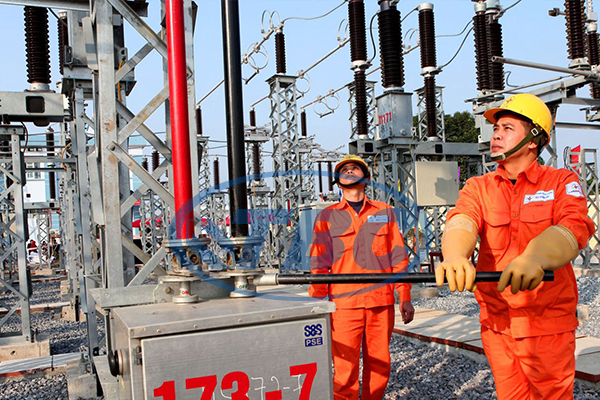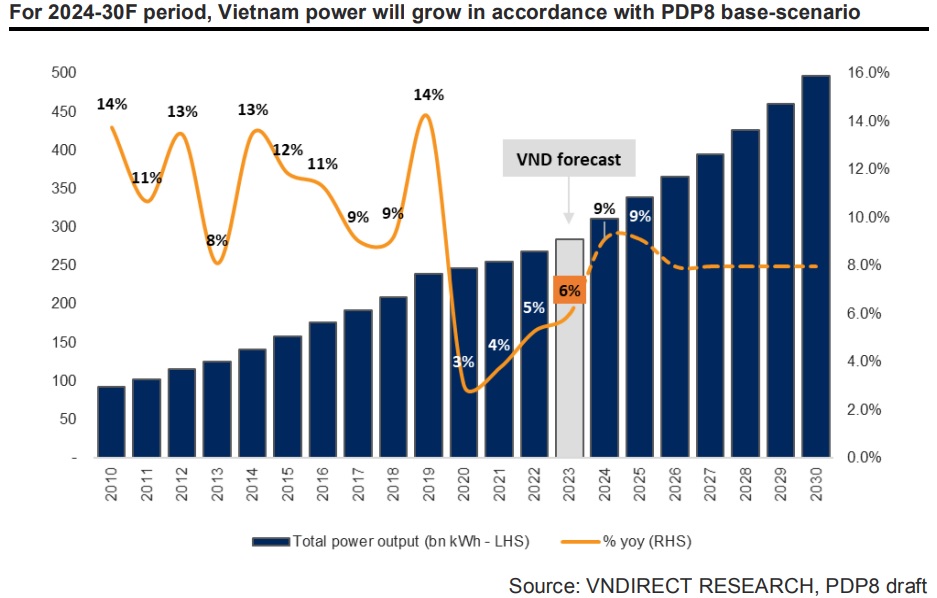Outlook for power consumption growth
The power consumption growth in Vietnam will stay below the PDP8 forecasted level in 2023, said VNDirect.

In 2022, Vietnam's total power consumption growth reached 5.3% year on year.
>> Rooftop solar power enterprises struggle with dual challenges
In 2021, Vietnam's total power demand will be made up of 53% from industry - construction, 39% from residential consumption - service, and the remainder from agriculture and other activities. The output/GDP growth ratio fell from 1.9x in the 2010-15 period to 1.4x in the 2015-20 timeframe.
This is comprehensible, according to VNDirect, considering that Vietnam's energy consumption part for Industry - Construction accounted for more than half of overall consumption, while the sector's GDP contribution remained at 37% of total GDP. Notably, Vietnam has several energy-intensive industries such as cement and steel production, which are expected to grow in importance in the future.
Moving forward to 2022, Vietnam's total power consumption growth reached 5.3% year on year, falling below GDP growth for the first time and falling far short of the PDP8's low case prediction of 8.4% year on year. As a result, the production growth/GDP growth ratio plummeted dramatically to 0.7x. According to Mr. Nguyen Duc Tung, analyst of VNDiret, the modest growth would be driven by low electricity demand among two primary groups.
First, industrial - construction power consumption fell as a consequence of weaker output in high-power-consuming sectors such as cement, steel, and electronics, while construction activity slowed as a result of the property market's freeze. Export activities were also affected in the context of global economic challenges, particularly among Vietnam's main trade partners, such as the United States, China, and Europe.
The multiple channel effect has drowned IIP growth and sector GDP growth since 2H22 and has continued through 1Q23, lowering national power consumption. Industry - Construction power consumption drives IIP and GDP growth; we find a more severe impact during the absence of power-intensive sectors, as can be shown in 2H22.
>> What is the outlook for coal-fired power?
Second, when the 2022 hot season had lower temperatures than typical, dragging down sudden demand in the summer, power demand for the residential sector grew less than predicted. Residential - Service power consumption increased at a 9.5% CAGR from 2010 to 20; however, overall weight decreased from 44% to 39%, with a lower percentage from the Residential category.

“We regard the sector's growth as fundamentally related to population growth and increased access to power. The increasing demand for air conditioning and the switch from fossil fuel to electricity cooking demonstrated a greater level of life among Vietnamese inhabitants. As a result, researchers observed that under the PDP8, income per capita and urbanization rate will be the key determinants impacting this group's consumption.”, said Mr. Nguyen Duc Tung.
VNDirect anticipates a more cautious 6% yoy increase in power consumption in 2023F, which corresponds to the MOIT's 2023 market operation plan level. The growth rate is 38% lower than the high-case scenario and 28% lower than the low-case scenario, as stated in the PDP8 draft: "The domestic construction sector will be severely impacted by weaker demand from the property market, which will last at least through the rest of 2023." As a result, we anticipate that the steel and cement industries would be affected. However, we anticipate a surge in public investment this year, which will help to lift demand for these industries and offset the output loss from the real estate market.
On the other hand, we find that predictions of a hotter summer will drive increased residential power consumption, somewhat balancing the low industrial power demand in 2023F since the El Nino phase is projected to return in May 2023.
“We compare actual power consumption growth to the Power Development Plan (PDP) prediction to assess the efficiency and effectiveness of Vietnam's power system. Actual output growth was lower than the PDP6 predicted level from 2006 to 2014. However, the gap narrows from 2015 (PDP 7) as forecasted output growth yielded a more accurate number, before deviating due to an unexpected Covid-19 in 2020. As a result, we anticipate that Vietnam's total power consumption will continue to expand in line with the PDP8 draft's base-case scenario of 8.4% CAGR.”, said Mr. Nguyen Duc Tung.








